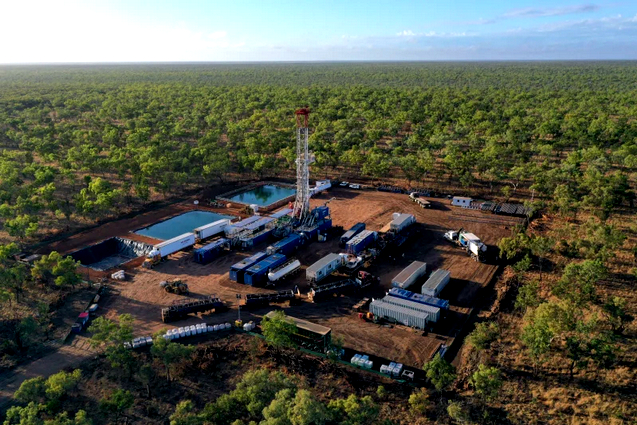Taxpayers will fund the private sector to accelerate gas exploration across Australia, with the federal government’s new strategy pinpointing locations off the coast of Victoria and the Northern Territory’s Beetaloo Basin as priorities for development.
The national gas infrastructure plan, released on Friday, says the government must act to alleviate the risk of gas supply shortfalls and support companies to open up new gas basins and construct gas pipelines.
A fortnight after nations at the Glasgow climate meeting, including Australia, affirmed the need to keep global warming within 1.5°C and phase out “inefficient” fossil fuel subsidies, the new plan has angered climate and environment groups, which describe it as “corporate welfare”.

|
|
Energy Minister Angus Taylor has been a strong proponent of gas
industry expansion. Credit: Alex Ellinghausen. |
The plan’s modelling suggests at least one new basin will be required to meet projected domestic and export requirements.
“There may be circumstances where private sector investment is not available in time to ensure priority infrastructure projects are in place when required,” the plan says. “In such conditions, the government stands ready to drive new infrastructure development.”
Climate policy 
|
|
|
Australia’s energy market operator, AEMO, has warned that Victoria and the other southern states face a shortfall of natural gas on peak-demand winter days by 2024, and probable gas price rises.
To date, $285 million has been committed by the federal government to the development of private gas projects, including $224 million for the Beetaloo Basin in the Northern Territory and $21 million for Queensland’s North Bowen and Galilee Basin.
The gas industry’s expansion sets Australia at odds with the global shift towards renewables. Earlier this year the International Energy Agency released analysis that found the global route to net zero emissions was “narrow and extremely challenging”, and that no new fossil fuel projects should be approved.
The federal priorities include the development of the Port Kembla gas terminal in NSW, and envisages opening up new gas basins.
The Beetaloo Basin in the Northern Territory should be brought into production by 2025, Narrabri in NSW from 2026 and Queensland’s Galilee and North Bowen basins in production by 2028, the plan says.

|
|
An alliance of residents, local businesses, and
environmentalists have failed to stop Santos’ coal seam gas
plans in New South Wales. Credit: Getty Images AsiaPac
|
Protect Country Alliance spokesperson Graeme Sawyer said the fracking industry in the Northern Territory, still in an exploratory phase, was being supported by “corporate welfare”.
“The Morrison government would be better off giving taxpayer money to just about any other industry if it wanted to seriously stimulate the economy,” Mr Sawyer said.
Demand for natural gas remains strong in Australia and Asia to replace coal, providing back up for renewables and to underpin industrial growth, said Andrew McConville, the chief executive of gas industry body APPEA.
“The National Gas Investment Plan confirms the importance of investment to bring gas to the market. Our members have announced more than $27 billion in new investment this year alone and analysis from EY suggests that could reach $350 billion under the right investment settings,” Mr McConville said.
The Climate Council’s head of research, Dr Simon Bradshaw, described the plan as a “disaster”.
“What part of gas is a polluting fossil fuel does this government not understand? The science is very clear: to avoid a climate catastrophe, fossil fuels must stay in the ground,” he said.

|
|
The Beetaloo basin gas project in the Northern Territory has
attracted protests and now a climate suit against federal
Resources Minister Keith Pitt. |
Environmental protection 
|
| Can lawsuits, boardroom takeovers and protests save the planet? |
This would not be classed as “green” hydrogen, which is produced with renewable energy.
Not everyone is convinced Australia faces a looming gas shortage. Environment Victoria analysis found there is enough gas supply capacity in Victoria until 2027.
Over the following three years there is a shortfall of between 26 petajoules (PJ) and 85 PJ, but the adoption of gas-demand reduction measures, like increasing energy efficiency and electrification, eliminates the forecast shortfall.
Links
- 2021 National Gas Infrastructure Plan (pdf)
- ‘No justification’: Government commits $285 million to gas development
- This is not economic modelling on net zero, it’s adjacent to it
- Australia’s Long-Term Emissions Reduction Plan (pdf)
- Treasury under Labor to model climate change impact on economy and budget
- International Energy Agency calls last drinks on fossil fuels

No comments:
Post a Comment